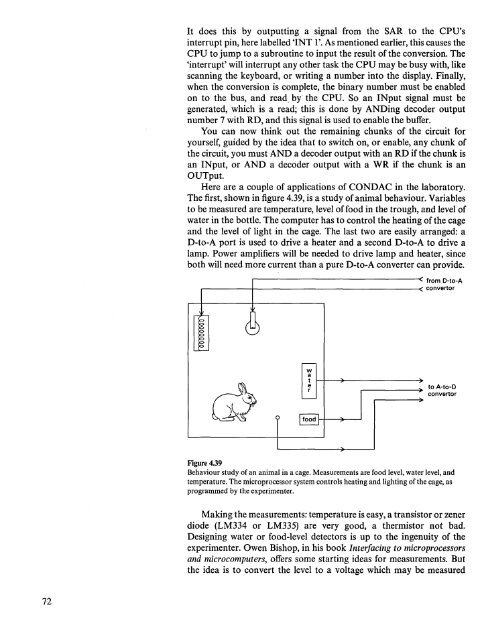Microcomputer Circuits and Processes
Microcomputer Circuits and Processes
Microcomputer Circuits and Processes
You also want an ePaper? Increase the reach of your titles
YUMPU automatically turns print PDFs into web optimized ePapers that Google loves.
It does this by outputting a signal from the SAR to the CPU's<br />
interrupt pin, here labelled 'INT 1'.As mentioned earlier, this causes the<br />
CPU to jump to a subroutine to input the result of the conversion. The<br />
'interrupt' will interrupt any other task the CPU may be busy with, like<br />
scanning the keyboard, or writing a number into the display. Finally,<br />
when the conversion is complete, the binary number must be enabled<br />
on to the bus, <strong>and</strong> read, by the CPU. So an INput signal must be<br />
generated, which is a read; this is done by ANDing decoder output<br />
number 7 with RD, <strong>and</strong> this signal is used to enable the buffer.<br />
You can now think out the remaining chunks of the circuit for<br />
yourself, guided by the idea that to switch on, or enable, any chunk of<br />
the circuit, you must AND a decoder output with an RD if the chunk is<br />
an INput, or AND a decoder output with a WR if the chunk is an<br />
OUTput.<br />
Here are a couple of applications of CONDAC in the laboratory.<br />
The first, shown in figure 4.39, is a study of animal behaviour. Variables<br />
to be measured are temperature, level of food in the trough, <strong>and</strong> level of<br />
water in the bottle. The computer has to control the heating of the cage<br />
<strong>and</strong> the level of light in the cage. The last two are easily arranged: a<br />
D-to-A port is used to drive a heater <strong>and</strong> a second D-to-A to drive a<br />
lamp. Power amplifiers will be needed to drive lamp <strong>and</strong> heater, since<br />
both will need more current than a pure D-to-A converter can provide.<br />
r-----------------











